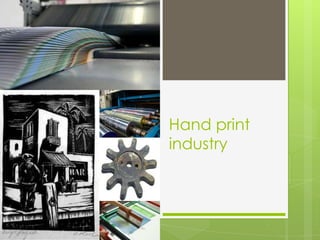Hand print industry
- 2. Method of hand print Etching= The artist draws with a needle on to a copper, zinc or steel plate that has been covered with an acid resistant wax. When the plate is immersed in acid, the bare metal, exposed by the lines of the drawing, is eroded. The depth of the `etch’ is controlled by the amount of time the acid is allowed to `bite’ the metal. The longer in acid, the deeper the line and the darker it will print. Advantage=Many circuits can be etched at once Disadvantage=circuit needs to be updated
- 3. Screen printing Method= 1.Mesh is stapled to a wooden or metal frame 2.Masking tape stuck around underside of the screen 3.Stencil design cut 4.Stencil placed under frame but above paper 5.Line of ink placed at one end of screen 6.Use squeegee to draw ink across screen, pressing firmly 6.Carefully lift screen 7.Evaluate and repeat Advantages The screen printing process affords one the opportunity to print images and text on a variety of promotional items. Unlike other printmaking techniques, such as intaglio or relief, screen printing allows many prints to be created before a reapplication of ink is necessary, which makes screen printing very useful commercially.Disadvantages Images for screen printing have to be simple in design and reduced to definite lines or shapes that will print well. While screen frames are durable, and can be reused many times, they can eventually become warped and uneven. Most hand-stencils are very fragile and break down faster than emulsion-based processes.
- 4. lithography Lithography is used for medium and long print runs of products such as magazines, posters, packaging and books. Advantage=it is very fast and it is cheap and produces good clear images Disadvantage=it cannot produce very highquality prints.
- 5. linocut Linocut printing is a process of a type of woodcut in which a sheet of linoleum, floor covering to be used for the upper surface. Advantage=product that has a soft surface in which it can then be cut with ease Disadvantage=the cost of producing rag based papers is a high expense.
- 6. mechanical Letterpress=This is a form of relief printing. In relief printing, the parts to be printed are raised up from the base plate. Letterpress printing can be used to produce both type and illustrations. It is used for small printing jobs such as business cards and stationery.
- 7. Woodcut This is when which an image is carved into the surface of a block of wood, with the printing parts remaining level with the surface while the non-printing parts are removed. Advantages=it is cheap to buy
- 8. Screen process Screen printing was around in 1910, A squeegee is pulled across the screen and ink enters the open areas to create an impression of the image on another surface. Advantage=allows many prints to be created before a reapplication of ink is necessary Disadvantage=Images for screen printing have to be simple in design
- 9. gravure With gravure printing an image is etched on the surface of a metal plate or cylinder so that the image you want to print is in the recesses or depressions not the raised part of the plate (unlike relief printing where the image is raised). The main advantage of gravure printing is in long- runs and quality. Gravure printing is disadvantaged in short runs
- 10. Digital printing
- 11. Photocopying Photocopying is a process of machine to make paper copies. An advantage is that a paper or document can be easily copied and a disadvantage is that it can aid in fraudulent document creation.
- 12. Laser printing Laser printing is an electrostatic digital printing process that rapidly produces high quality text and graphics by passing a laser beam over a charged drum to define a differentially charged image. Advantages and disadvantages they print on their own without needing to be watched. This is the highest quality type of printer on in the home consumer market. The disadvantage is that it cannot perform duplicate printing functions and is a more costly unit overall.
- 13. inkjet Inkjet printing is a type of computer printing that creates a digital image by propelling droplets of ink onto paper, plastic, or other substrates. advantage is they are cheap to buy. And most of them you can either refill the cartridges or connect a continuous ink system to avoid the high cost of new cartridges. Disadvantage is they need special papers to give best resolution.
- 14. Desktop publishing desktop publishing is the process of using the computer and specific types of software to combine text and art work to produce documents properly formatted for print, Web
